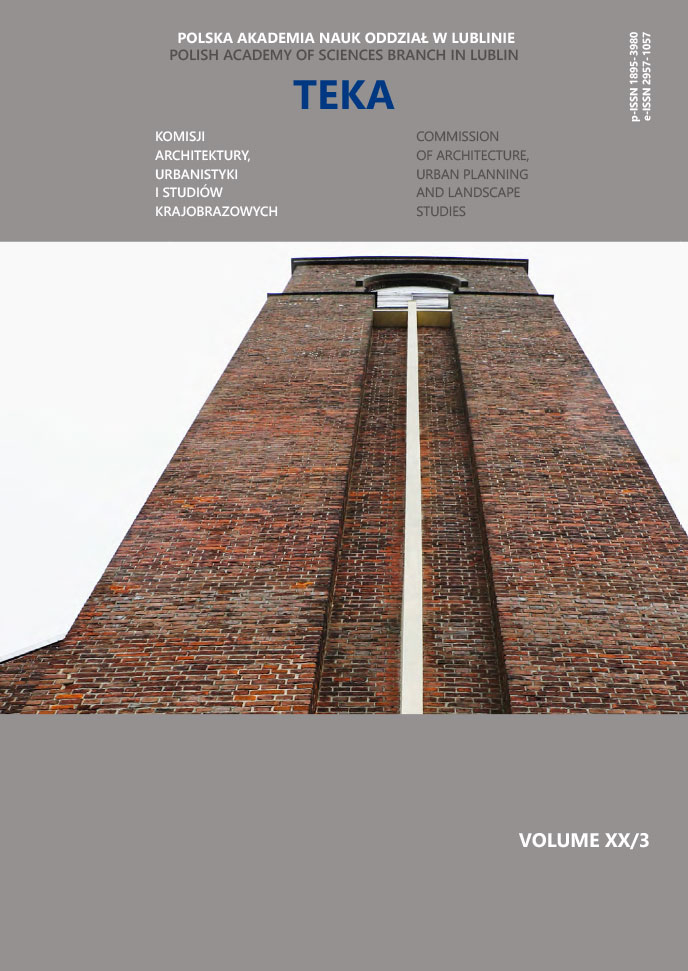Copying Geological Relics in the Process of Preservation and Restoration of Architectural Monuments
Article Sidebar
Open full text
Issue Vol. 20 No. 3 (2024)
-
Urban Phenomenon of Lviv. Identification and Regeneration of Valuable Urban Complexes
Mykola Bevz7-23
-
The Influence of the Material-structural Characteristics of Travertine, Limestone and Alabaster on the Features of Their Use in the Construction of the Assumption Cathedral in Princely Halych
Ulyana Bornyak, Viktor Melnyk24-31
-
The Role of the Basilian Monasteries in the Formation of the Sacred Space of the Cities and Villages of Ukraine
Lesia Chen32-39
-
Copying Geological Relics in the Process of Preservation and Restoration of Architectural Monuments
Оlena Stasyuk, Tetiana Dziubanovska40-44
-
Return of the Authentic Artistic Decor of the Assembly Hall of the Main Building of the Lviv Polytechnic University
Mykola Bevz, Serhii Hetmanchuk, Myron Demkiv45-53
-
The Place of the Lost Architectural and Urban Planning Heritage in the Modern Environment of Ukrainian Cities
Volodymyr Gaidar54-61
-
Analiza stanu zachowania obiektów sakralnych XX-lecia międzywojennego na Lubelszczyźnie
Weronika Kendzierawska, Maciej Trochonowicz62-70
Archives
-
Vol. 20 No. 3
2024-12-27 7
-
Vol. 20 No. 2
2024-12-27 7
-
Vol. 20 No. 1
2024-12-27 8
-
Vol. 19 No. 2
2023-12-29 11
-
Vol. 19 No. 1
2023-12-19 13
-
Vol. 18 No. 4
2022-12-30 5
-
Vol. 18 No. 3
2022-12-27 5
-
Vol. 18 No. 2
2022-12-27 5
-
Vol. 18 No. 1
2022-12-27 4
-
Vol. 17 No. 4
2021-12-30 11
-
Vol. 17 No. 3
2021-12-30 9
-
Vol. 17 No. 2
2021-12-30 8
-
Vol. 17 No. 1
2021-12-30 8
-
Vol. 16 No. 4
2020-12-30 11
-
Vol. 16 No. 3
2020-09-30 10
-
Vol. 16 No. 2
2020-06-30 11
-
Vol. 16 No. 1
2020-03-31 10
Main Article Content
DOI
Authors
Abstract
Lviv is a historic city known for its architectural landmarks. The historic part of Lviv, which is included in the UNESCO World Heritage List, has the majority of its buildings constructed from stone. This architecture – walls, towers, townhouses on Rynok Square, sacred structures, and so on – requires preservation, constant care, and often restoration. For professional and thorough restoration of stone objects, it is essential to understand the nature of the material from which the monument was built. Here, collaboration with the Faculty of Geology at Lviv University provides invaluable support. Professors and geology students study the geological material from which Lviv was built, including its precise dating and origin. Such information is particularly valuable when it is necessary to supplement damaged details or replicate lost ones.
At the same time, during such detailed study of geological materials on Lviv’s streets, geology students discover fossils or remnants of ancient organisms, which are valuable scientific objects. Most often, these are various shells, and sometimes plant leaves. A true gem discovered on a stone in a street curb at 6 Akademika Hnatyuka Street in Lviv is a fossil of a starfish. This unique and extraordinary geological relic undoubtedly deserves preservation. Simultaneously, this geological relic is part of the city’s street, meaning it is part of its architecture, and currently cannot be removed.
As part of the collaboration between Lviv University and Polytechnic University, involving the Department of Geology and the Department of Architecture and Restoration, a mold was taken from the relic, and subsequently, a replica of the starfish fossil was created. Today, the object is housed in the university’s geological museum and is one of its valuable exhibits. This article analyzes the methodology for copying geological relics and presents the step-by-step process of creating a copy of such a relic, using the example of the starfish from Lviv.
Keywords:
References
Harkot, Natalia, (2016). Conservation of two ancient rock images (petroglyphs) and making their copies in the Pishchyna tract on the territory of the Tustan reserve. Monuments of Tustan in the context of the Carpathians development in prehistoric times and in the Middle Ages; problems of their preservation and use ІІІ. 128−129.
Melnyk, Viktor, Stasyuk, Оlеnа, (2017). Conservation of architectural details and art works made of plaster. Methodological instructions for program tasks of the subject “Conservation project” specialty 6.02020601 “artworks Conservation”. Publishing House of Lviv Polytechnic National University, Lviv.
Tuzyak, Yaruna, Kirchanova, Окsаnа, (2022). Collection of fossil plant and animal remains of the Paleontological Museum of the Ivan Franko National University of Lviv: meaning, current state, prospects for use Paleontological collection 2022. № 54. С. 5−20 ISSN 2078-6212.
Dick, Parry, (2006). An extraordinary technique of antiquity, Warszaw.
Buell, Carl Dennis, (2007). Evolution: what the fossils say and why it matters. New York: Columbia University Press. P. 50—53.
Marjorie, Trusted, (2007). The Making of Sculpture. Publisher: V & A Publishing.
Remondino, Fabio (2011). “Heritage Recording and 3D Modeling with Photogrammetry and 3D Scanning”. Remote Sensing. DOI: https://doi.org/10.3390/rs3061104
Tuzyak, Ya., Іvanina, А., (2021). Hotsanyuk H., Shaynoha I., Cherniak A. From paleontological collections to the Paleontological Museum of Lviv University as an object of historical, cultural and natural values // Journ. Geol. Geograph. Geoecology. 2021. Nо. 30 (4). P. 781−793. DOI: https://doi.org/10.15421/112172. DOI: https://doi.org/10.15421/112172
Сiabach, Jerzy (1998). Resins and plastics used in the conservation of monuments. Torun, Mikołaj Kopernik University.
Skavron, Bohdan, (2013). Fossilized life of the Galician Sea Zbruč [online] Available at: https://zbruc.eu/search/node/%D0%A1%D0%BA% [Cited November 11, 2024].
The Geological Society of London – Prehistoric fossil collectors. [online] Available at: www.geolsoc.org.uk. [Cited November 16, 2024].
Article Details
Abstract views: 157



